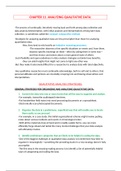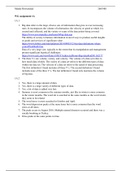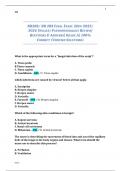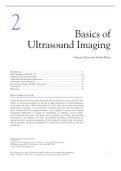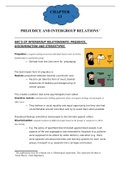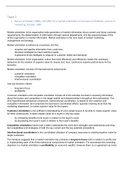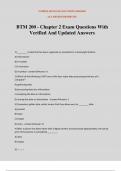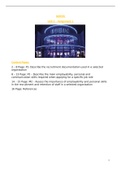CHAPTER 11: ANALYZING QUALITATIVE DATA:
-The process of continually, iteratively moving back and forth among data collection and
data analysis/interpretation, with initial analyses and interpretations driving later data
collection, is sometimes called the constant comparative method.
-Strategies for analyzing qualitative data are less prescriptive than those for analyzing
quantitative data.
-Also, they tend to rely heavily on inductive reasoning processes:
-The researcher observes a few specific situations or events and, from them,
imposes specific meanings on them—often by coding them in some way—
and then draws conclusions about a more general state of affairs.
-Such flexibility and open-endedness in data analysis strategies certainly have benefits;
-they can yield insights that might not come to light any other way
-But they make it extremely difficult for a researcher to analyze data with total objectivity.
-Any qualitative researcher must continually acknowledge, both to self and to others, that
personal attitudes and opinions are inevitably creeping into and biasing observations and
interpretations.
QUALITATIVE ANALYSIS STRATEGIES:
GENERAL STRATEGIES FOR ORGANIZING AND ANALYSING QUALITATIVE DATA:
1. Convert the data into one or more forms that will be easy to organize and analyze.
-For example, transcribe audiotaped interviews.
-Put handwritten field notes into word processing documents or a spreadsheet.
-Electronically scan photocopied documents.
2. Organize the data in a preliminary, superficial way that will enable you to locate
them easily as you proceed.
-For example, in a case study, this initial organizational scheme might involve putting
notes about various incidents and events in chronological order.
-With all the materials close at hand and in readily usable forms, you can more
efficiently forge ahead and tackle the many mental challenges that your data analysis
will ultimately involve.
3. Identify preliminary categories that are likely to be helpful in coding the data.
-One of the biggest challenges in qualitative data analysis is to determine how best to
organize it meaningfully—something the preceding ducks-in-a-row strategy doesn’t fully
accomplish.
-The first step in the meaning-making process is to identify a list of potentially helpful
ways of categorizing and coding the data.
, -Typically, the researcher also identifies subcategories—subcodes—for some or all of the
codes.
-For example, under a general code Emotions, a researcher might include such
subcodes as Joy, Anxiety, and Depression.
-Sometimes researchers pull certain codes or subcodes directly from things that
participants tell them (e.g., “I worry about my family” or “The popular kids are snobs”);
such codes are called in vivo (i.e., “living”) codes.
4. Divide the data into meaningful units that will be individually coded.
-In some qualitative studies the meaningful units to be coded are clear-cut; for example,
this might be true when the objects of study are paintings, television commercials, or
specific movements in classical music.
-But especially in verbal materials, such as interview data or lengthy written works, the
data need to be systematically broken into small segments—perhaps individual phrases
or sentences—that will be coded separately.
5. Apply the initial coding scheme to a subset of the data.
-In a sense, this strategy involves pilot testing the list of codes to determine whether it
will adequately capture the multidimensional meanings that the data hold.
-Such a pilot test is likely to reveal certain weaknesses in the list.
-For example, initial codes might:
• Be too vague to enable consistent, reliable categorization of the data
• Reflect overlapping ideas (and thus might be combined into a single code)
• Be too item-specific to be of use in making generalizations about the data
• Omit certain themes that appear to be important in the overall data set
-This might also be a good time to identify parts of the data set that are, for all intents
and purposes, irrelevant to the research problem and can be omitted from future
analysis.
6. Construct a final list of codes and subcodes and define each code and subcode as
specifically and concretely as possible.
-The goal here is to create a list that ensures reasonable consistency—reliability—in
coding the data.
-The list should be definitive enough that two different researchers would be highly
likely to code any single item in the same way.
-One common strategy for enhancing coding reliability is to include specific examples
(e.g., quotes from participant interviews) to illustrate each code and subcode.
7. Consider using two or more raters to code the data independently.
-Two or more people independently code the data.
-Here we are talking about interrater reliability: the extent to which two or more
individuals provide identical judgments.
-The process of continually, iteratively moving back and forth among data collection and
data analysis/interpretation, with initial analyses and interpretations driving later data
collection, is sometimes called the constant comparative method.
-Strategies for analyzing qualitative data are less prescriptive than those for analyzing
quantitative data.
-Also, they tend to rely heavily on inductive reasoning processes:
-The researcher observes a few specific situations or events and, from them,
imposes specific meanings on them—often by coding them in some way—
and then draws conclusions about a more general state of affairs.
-Such flexibility and open-endedness in data analysis strategies certainly have benefits;
-they can yield insights that might not come to light any other way
-But they make it extremely difficult for a researcher to analyze data with total objectivity.
-Any qualitative researcher must continually acknowledge, both to self and to others, that
personal attitudes and opinions are inevitably creeping into and biasing observations and
interpretations.
QUALITATIVE ANALYSIS STRATEGIES:
GENERAL STRATEGIES FOR ORGANIZING AND ANALYSING QUALITATIVE DATA:
1. Convert the data into one or more forms that will be easy to organize and analyze.
-For example, transcribe audiotaped interviews.
-Put handwritten field notes into word processing documents or a spreadsheet.
-Electronically scan photocopied documents.
2. Organize the data in a preliminary, superficial way that will enable you to locate
them easily as you proceed.
-For example, in a case study, this initial organizational scheme might involve putting
notes about various incidents and events in chronological order.
-With all the materials close at hand and in readily usable forms, you can more
efficiently forge ahead and tackle the many mental challenges that your data analysis
will ultimately involve.
3. Identify preliminary categories that are likely to be helpful in coding the data.
-One of the biggest challenges in qualitative data analysis is to determine how best to
organize it meaningfully—something the preceding ducks-in-a-row strategy doesn’t fully
accomplish.
-The first step in the meaning-making process is to identify a list of potentially helpful
ways of categorizing and coding the data.
, -Typically, the researcher also identifies subcategories—subcodes—for some or all of the
codes.
-For example, under a general code Emotions, a researcher might include such
subcodes as Joy, Anxiety, and Depression.
-Sometimes researchers pull certain codes or subcodes directly from things that
participants tell them (e.g., “I worry about my family” or “The popular kids are snobs”);
such codes are called in vivo (i.e., “living”) codes.
4. Divide the data into meaningful units that will be individually coded.
-In some qualitative studies the meaningful units to be coded are clear-cut; for example,
this might be true when the objects of study are paintings, television commercials, or
specific movements in classical music.
-But especially in verbal materials, such as interview data or lengthy written works, the
data need to be systematically broken into small segments—perhaps individual phrases
or sentences—that will be coded separately.
5. Apply the initial coding scheme to a subset of the data.
-In a sense, this strategy involves pilot testing the list of codes to determine whether it
will adequately capture the multidimensional meanings that the data hold.
-Such a pilot test is likely to reveal certain weaknesses in the list.
-For example, initial codes might:
• Be too vague to enable consistent, reliable categorization of the data
• Reflect overlapping ideas (and thus might be combined into a single code)
• Be too item-specific to be of use in making generalizations about the data
• Omit certain themes that appear to be important in the overall data set
-This might also be a good time to identify parts of the data set that are, for all intents
and purposes, irrelevant to the research problem and can be omitted from future
analysis.
6. Construct a final list of codes and subcodes and define each code and subcode as
specifically and concretely as possible.
-The goal here is to create a list that ensures reasonable consistency—reliability—in
coding the data.
-The list should be definitive enough that two different researchers would be highly
likely to code any single item in the same way.
-One common strategy for enhancing coding reliability is to include specific examples
(e.g., quotes from participant interviews) to illustrate each code and subcode.
7. Consider using two or more raters to code the data independently.
-Two or more people independently code the data.
-Here we are talking about interrater reliability: the extent to which two or more
individuals provide identical judgments.

